An effective workout should have three components. Firstly, you should start with a warm-up to prepare your muscles and joints for what you are about to do. Elements of a warm-up include a progressive cardio pulse raiser, dynamic stretches, mobility exercises, muscle activation exercises, and ramped practice sets. You don’t need to do all these things, and your warm-up should match the demands of your workout, so tailor it to your needs.
Once you are warmed up, it’s time to work out, be that cardio, strength training, or both. A thorough and appropriate warm-up means you should be able to push your body hard and perform at your best while limiting your risk of injury.
After your workout, you may be tempted to collapse in a heap, head off to the showers, and then enjoy a well-earned protein shake.
But, before doing any of those things, you should also do a cool-down. Unfortunately, a lot of exercisers skip this part of their session or pay it very little attention.
That’s unfortunate because what you do at the end of your workout could have a significant impact on your progress and performance in your next session.
So, in this article, we explain why and how to cool down and provide you with some great cool-down exercises.
Why Cool Down, Anyway?
It probably won’t surprise you to learn that a cool-down is the opposite of a warm-up. Where warm-ups are designed to ease you into your workout, cool-downs ease you back out again.
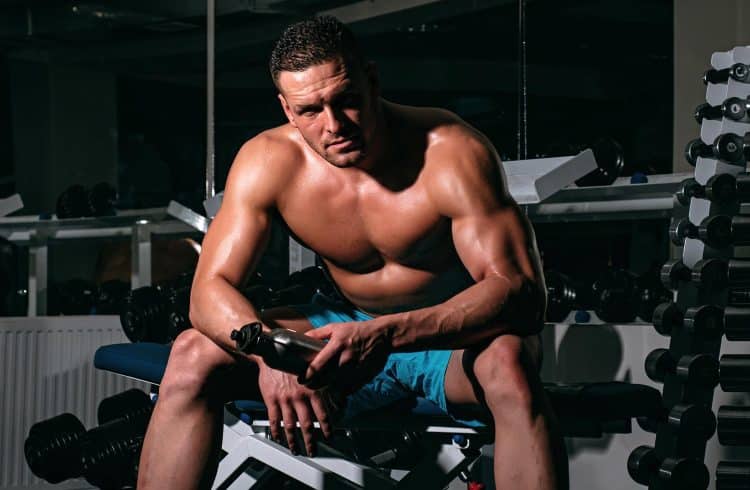
The aim of a cool-down is to return your body to as close to its pre-workout state as possible, which is called homeostasis. This includes lowering your heart and breathing rate, reducing muscle tension, mobilizing your joints, returning your muscles to their usual resting length, and starting the process of removing metabolic waste products from your muscle tissues.
Cooling down may help speed up recovery, so you can return to training sooner and reduce unwanted aches and pains, such as stiff joints and post-exercise muscle soreness.
It’s worth noting that there is very little scientific evidence to support the effects of cooling down after training (1). That’s because your body will adapt to your workout regardless of whether you cool down or not. However, there is plenty of anecdotal evidence supporting the effectiveness of cooling down, so it’s probably still worth doing.
If you are on the fence about cool-downs, don’t dismiss them entirely. Instead, use the information in this article and cool down after every workout for a month and see how you feel.
If you experience fewer post-exercise aches and pains or feel ready to train again sooner, you know cooling down works. But, if you feel no different after a month, you can just hit the showers and skip your cool down, safe in the knowledge that you aren’t missing out on any additional benefits.
How to Cool Down
While there are several phases of an effective warm-up, there are only two phases in a cool-down – a pulse lowerer and stretching/mobility exercises. As such, your cool down should only take about 5-15 minutes.
The actual length of your cool down will depend on how hard you just trained. The more intense your workout was, the longer you’ll probably need to spend cooling down. Also, if you trained a lot of different muscles, you’ll need a little longer to return them to their pre-training state.
So, how long should a cool down be? The simple answer is long enough to get the job done!
Pulse lowerer
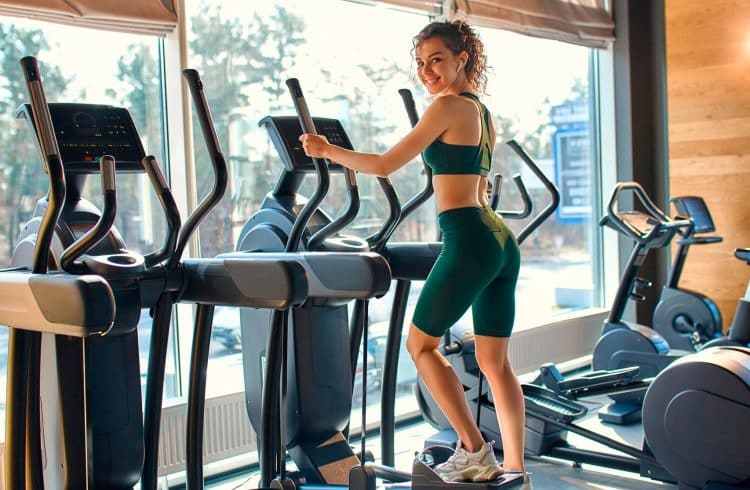
When you perform any exercise, blood is preferentially driven to the working muscles. This is called blood pooling. In addition, lactic acid and other waste products accumulate in this area. These metabolites are thought to be one of the causes of muscle soreness.
The pulse lower is designed to pump freshly oxygenated blood around your entire body to eliminate blood pooling, reoxygenate your muscles, and flush out metabolic waste products. It should also gradually lower your heart and breathing rate.
The most efficient pulse lowers are full-body cardio exercises, such as rowing, ellipticals, and air bikes. Start off at a moderate level of intensity and then decrease speed and effort over several minutes until your heart and breathing rate are close to their pre-exercise level.
Three to five minutes should be sufficient for most people.
By the end of your pulse lowerer, your heart and breathing rate should be close to normal, and your muscles may even feel somewhat reenergized after being flushed through with oxygenated blood. However, you must take care not to turn your pulse lowerer into a cardio workout, as that would somewhat defeat its purpose.
Flexibility and mobility
Once your heart and breathing rate is back to normal, you are ready to stretch and mobilize the muscles and joints you have just been training. The aim of this phase is to prevent any adaptive shortening of the muscles, improve muscle elasticity, promote good posture, and maybe even reduce muscle soreness.
Flexibility and mobility are similar and codependent but also somewhat different. Flexibility refers to the elasticity and extensibility of your muscles, while mobility is the freedom of movement at your joints.
As such, flexibility involves stretching and holding your muscles in a lengthened position, while mobility involves moving your joints through a wide range of motion.
Flexibility
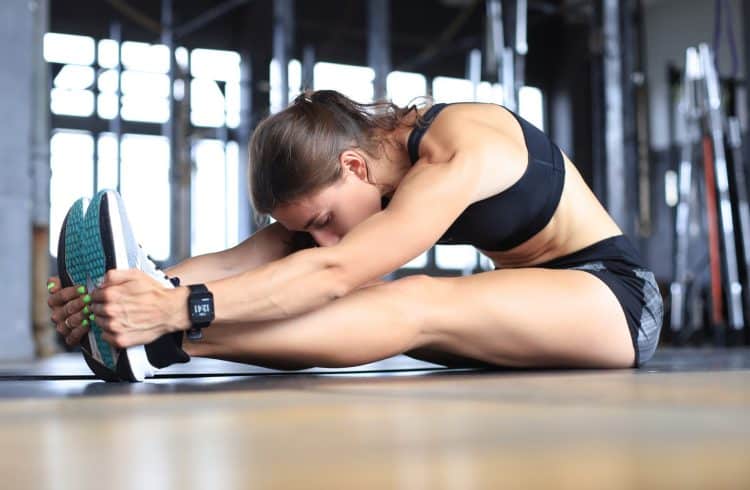
The best type of stretches for the cool down are static stretches. These involve easing into a stretch and then holding it for time. If you’ve got good flexibility, you only need to hold a stretch for 20-30 seconds to maintain your current muscle elasticity.
However, if your muscles are tight, you’ll need to hold your stretch for longer – typically 60 seconds or more.
You should customize your cool-down stretches based on your flexibility needs and the workout you’ve just done. Spend more time on the muscles that need it and less time on the muscles that don’t.
Example static cool-down stretches include:
- Supine hamstring stretch with strap
- Doorway chest stretch
- Prone quadriceps stretch
- Dead-hang full body stretch
- Seated adductor stretch
- Standing calf stretch
- Kneeling forearm stretch
Mobility
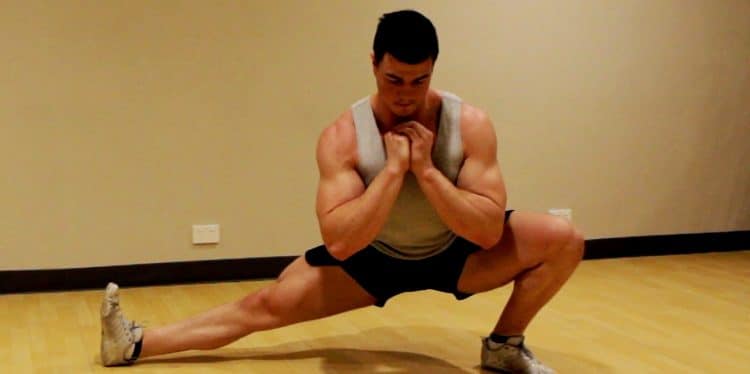
After statically stretching the muscles that need it most, you should then move on to mobilizing your primary joints, i.e., ankles, knees, hips, lower back, and shoulders.
Mobility exercises take the target joint through a large but relaxed range of motion. This increases synovial fluid production, which is your body’s very own lubricating and nourishing oil.
Good mobility exercises include:
- Squat and hip pry
- Cossack squat
- Hip hinge
- 90/90 hip opener
- Standing lumber spine twist
- Standing lateral flexion
- Arm circles
[sc name=”style-blue-box” ]
Remember, you don’t need to do all these stretching and mobility exercises. Instead, do the exercises for the muscles you have just trained. So, with that in mind, you may only need 2-3 movements from each list.
[/sc]
Cool Down Exercise Bonus – Foam Rolling
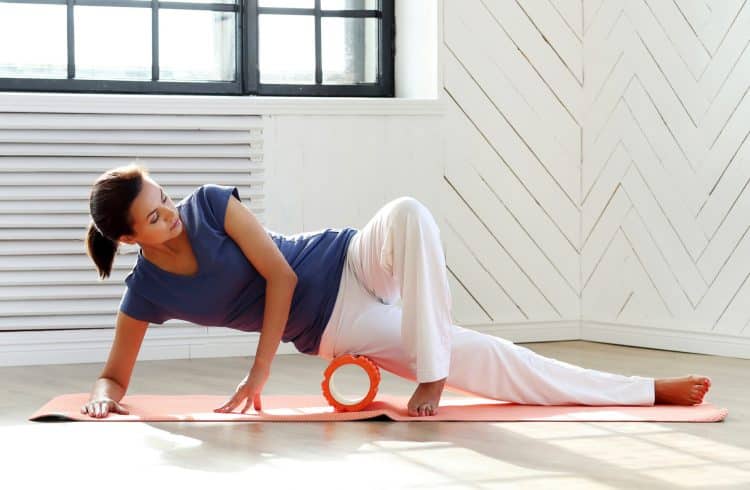
Foam rolling is a sort of deep tissue massage. Instead of having someone press down on your body, you lie on the roller and use your bodyweight to apply pressure to your muscles. By rolling up and down, you simulate massage-type movements, and with a bit of creativity and contortionism, you can use a foam roller on virtually every part of your body.
Like all types of massage, foam rolling increases blood flow, can lead to more relaxed muscles, and is a good way to treat and prevent a wide range of aches and pains. However, what separates foam rolling from regular massage is how it affects the fascia that surrounds your muscles.
What is fascia?
Fascia is the term used to describe the fibrous sheath that envelops all of your muscles. It helps keep your muscles separate and is an integral part of the muscular system.
However, fascia can get “gummed up” and adhere to the muscle it surrounds. This can reduce the range of motion and may also cause pain – often felt as hotspots or pressure points, which are areas of localized tenderness.
If ignored, these hotspots can reduce your range of motion and even lead to injury, so it’s a good idea to keep your fascia moving freely. Foam rolling is also known as a self-myofascial release which, as the name suggests, results in more freely-moving muscles and fascia.
Freeing up your fascia is a simple, if initially painful, process. Rolling the muscles will help get that fascia moving, eliminating any adhesions and hot spots. But, the more severe those adhesions are, the more painful and lengthy the process will be.
The key to successful foam rolling is to start off light and gradually increase your weight on the roller over several sessions. It might even take you a few weeks to work up to putting your entire weight on the roller.
Don’t worry; even light foam rolling can be very beneficial.
Here’s a basic foam rolling routine that’s perfect for after training as part of your cool-down, or you can do it on your rest days, or anytime your muscles feel like they need a massage.
Wrapping Up
The last thing you probably want to do after an intense workout is more exercise. But by spending a few extra minutes cooling down correctly, you may save yourself from unwanted muscle soreness and even speed up recovery so you can get back in the gym sooner.
The good news is that an effective cool-down doesn’t have to take long, and 5-15 minutes should be plenty for most people.
The best way to make your cool down as time-efficient as possible is to be prescriptive and focus almost entirely on the muscles you have just trained. For example, you don’t need to do cool-down exercises for your legs after an upper body workout.
Use the methods and exercises in this article to create the perfect cool-downs for your workouts. Your body will thank you for your time and effort!
Reference:
1. PubMed: Do We Need a Cool-Down After Exercise? A Narrative Review of the Psychophysiological Effects and the Effects on Performance, Injuries, and the Long-Term Adaptive Response https://www.ncbi.nlm.nih.gov


